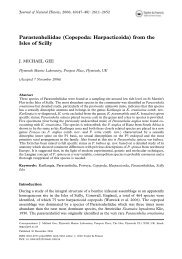An Updated Classification of the Recent Crustacea
An Updated Classification of the Recent Crustacea
An Updated Classification of the Recent Crustacea
Create successful ePaper yourself
Turn your PDF publications into a flip-book with our unique Google optimized e-Paper software.
would be a choice <strong>of</strong> <strong>the</strong> future for <strong>the</strong> reasons<br />
mentioned below.<br />
I think it is better to have your higher level classification<br />
to include only what is quite certain. The<br />
highest categories (classes) should <strong>the</strong>n be something<br />
like <strong>the</strong> following: Malacostraca, Branchiopoda,<br />
Remipedia, Copepoda, Mystacocarida, Branchiura,<br />
Thecostraca, Cephalocarida, Ostracoda,<br />
Tantulocarida, (Pentastomida).<br />
These are with <strong>the</strong> highest certainty all monophyletic<br />
(not considering that insects may go in<br />
somewhere). As for <strong>the</strong> grouping <strong>of</strong> <strong>the</strong>se taxa, we<br />
appear to know too little yet. As you know, this is<br />
reflected in <strong>the</strong> high number <strong>of</strong> different schemes<br />
put forward that all differ from each o<strong>the</strong>r. Perhaps<br />
it will take 50–100 years before we get <strong>the</strong> full story,<br />
if ever. The great advantage <strong>of</strong> having such a flat<br />
structure is that it would tell people what <strong>the</strong> crustacean<br />
community thinks is certain, but it would<br />
also point at what is unknown by not having any<br />
<strong>of</strong> <strong>the</strong>se weakly supported higher level taxa included<br />
(like Maxillopoda, Entomostraca, Thoracopoda,<br />
and <strong>the</strong> one you now suggest being comprised <strong>of</strong><br />
all non-branchiopod <strong>Crustacea</strong>). This will be a logical<br />
starting point for any students <strong>of</strong> <strong>the</strong> <strong>Crustacea</strong><br />
that want to address <strong>the</strong> higher level phylogeny. If<br />
a taxon like Maxillopoda is included, for example,<br />
<strong>the</strong>n <strong>the</strong> starting point is most likely already polluted.<br />
Submitted by Jørgen Olesen,<br />
University <strong>of</strong> Copenhagen, Denmark<br />
MAXILLOPODA: RHIZOCEPHALA<br />
Boschma (1928) is without any doubt <strong>the</strong> author<br />
<strong>of</strong> <strong>the</strong> family Lernaeodiscidae, but both <strong>the</strong> families<br />
Peltogastridae and Sacculinidae must be ascribed to<br />
Lilljeborg (1860). This has been duly checked.<br />
Boschma lived 1893–1976, and cannot possibly be<br />
<strong>the</strong> author <strong>of</strong> <strong>the</strong>se two families. Holthuis and I<br />
consulted Lilljeborg’s (1860) publication, a copy <strong>of</strong><br />
which is in our library; <strong>the</strong>re is not a shadow <strong>of</strong> a<br />
doubt concerning his authorship!<br />
Submitted by W. Vervoort,<br />
Rijksmuseum van Natuurlijke Historie,<br />
Leiden, The Ne<strong>the</strong>rlands<br />
MAXILLOPODA: COPEPODA<br />
I suggest you strictly adhere to what is already published.<br />
Names should in my view not be introduced<br />
un<strong>of</strong>ficially but through full and reviewed papers.<br />
Two PhD <strong>the</strong>ses have just been completed here with<br />
phylogenetic revisions <strong>of</strong> <strong>the</strong> Cyclopoida and one<br />
branch <strong>of</strong> Harpacticoida. I could tell you all <strong>the</strong><br />
changes <strong>the</strong>y entail but that would alter your list<br />
quite visibly. The Poecilostomatoida, e.g., are not a<br />
separate order but a specialised branch within Cyclopoida.<br />
There are many new families and o<strong>the</strong>rs<br />
had to be synonymized. So, please, stick to published<br />
and avoid cryptic information ( pers.<br />
comm.).<br />
Submitted by H. Kurt Schminke,<br />
Universität Oldenburg, Germany<br />
MAXILLOPODA: PENTASTOMIDA<br />
First, on a separate subclass Pentastomida—what<br />
can I say. You cite all <strong>the</strong> relevant papers that argue<br />
and provide evidence that <strong>the</strong>se are Branchiura, and<br />
yet you reject <strong>the</strong>se and separate <strong>the</strong>m. This is one<br />
<strong>of</strong> <strong>the</strong> few places where we have good apomorphies<br />
to unite <strong>the</strong> groups involved. If you accept Thecostraca,<br />
<strong>the</strong>n why not accept a single subclass Branchiura<br />
with two orders: Arguloida and Cephalobaenida?<br />
Concerning <strong>the</strong> Walossek arguments in <strong>the</strong> second<br />
paragraph: All this Cambrian apparent pentastomid<br />
says is that Pentastomida are older than we<br />
thought <strong>the</strong>y were. It does not argue against anything.<br />
You rightly point out that <strong>the</strong> fossils might<br />
not even be pentastomids. As to whe<strong>the</strong>r or not <strong>the</strong><br />
hosts ‘‘were on <strong>the</strong> scene,’’ you must be careful. <strong>Recent</strong><br />
issues <strong>of</strong> Science and Nature have featured a<br />
stunningly preserved early chordate that to all intents<br />
and purposes looks like it was drawn by old<br />
Al Romer himself when figuring a vertebrate ancestor.<br />
This Chengjiang fossil in fact trumps Brusca’s<br />
suggestion, which is true by <strong>the</strong> way, that <strong>the</strong><br />
conodont animal is a chordate.<br />
Submitted by Frederick R. Schram,<br />
Zoölogisches Museum, Amsterdam<br />
OSTRACODA<br />
I am sure <strong>the</strong> classification and appended rationale<br />
will be useful and will advance <strong>the</strong> study <strong>of</strong> crustaceans.<br />
I am still <strong>of</strong> <strong>the</strong> opinion that <strong>the</strong> suborders<br />
<strong>of</strong> <strong>the</strong> order Podocopida are unnecessary and<br />
should be deleted, especially as each contains only<br />
one superfamily except for <strong>the</strong> Cypridoidea, all superfamilies<br />
<strong>of</strong> which are monotypic.<br />
It is likely that <strong>the</strong> paleontologists will follow <strong>the</strong><br />
classification that is published in <strong>the</strong> revised Treatise,<br />
and that classification will be determined by<br />
Pr<strong>of</strong>essor Whatley and his team <strong>of</strong> specialists,<br />
which includes Dr. Martens.<br />
As for -acea v. -oidea, you must <strong>of</strong> course be consistent<br />
throughout your classification. Some volumes<br />
<strong>of</strong> <strong>the</strong> Treatise (most notably <strong>the</strong> revision <strong>of</strong><br />
<strong>the</strong> brachiopods) have now begun to follow <strong>the</strong> recommendation<br />
<strong>of</strong> <strong>the</strong> ICZN, but you should realize<br />
that <strong>the</strong>se are only recommendations, not rules; and<br />
<strong>the</strong>y may sometimes lead to <strong>the</strong> curious duplications<br />
<strong>of</strong> names among superfamilies and genera.<br />
Good luck with <strong>the</strong> classification. I look forward<br />
to seeing <strong>the</strong> final version.<br />
106 Contributions in Science, Number 39 Appendix I: Comments and Opinions











